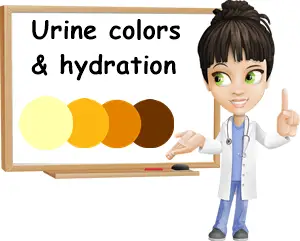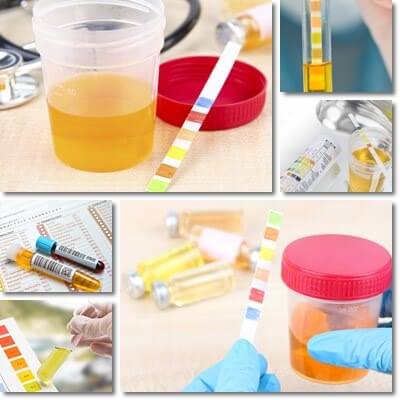Urine is a secondary product of normal human metabolism and an effective and precise indicator of hydration levels and general kidney health. And one of the most important aspects to consider when looking to asses your health is urine color. For the most part, urine should be light in color, pale straw or light yellow and clear, indicating an optimal level of hydration. Darker colored urine along with other symptoms such as a foul smell, abnormal sediments and even a sweet odor are signs that something is not right.
The longer the abnormal color persists, the more indicated a visit to the doctor’s office becomes. The causes of changes in urine color are diverse and range from eating certain foods such as beets, orange and purple carrots or asparagus, drinking pigmented fruit or vegetable juices, coffee or alcohol, to taking certain medicines like antibiotics, dietary supplements like B vitamin complexes to urinary tract infections, kidney infections, kidney stones, liver or gallbladder problems and others.

Most of the time, changes in urine color are temporary and represent no reason for concern. At the same time, certain colors may be symptoms of more serious underlying medical conditions and require you to see a doctor for diagnosis and treatment. The same is true for stools colors – see article on Stool Colors: What They Mean. But whether it’s a case of drinking too little water, having foods or beverages containing certain dyes or time to see a doctor, different urine color should help tell you what’s going on in your body.
1) Clear urine, no color
If urine is transparent and you cannot discern any particular color, it likely means that you are drinking too much water and possibly other fluids. Maybe more than you actually need. Fluid intake is the first thing you can determine based on a person’s urine color. Discoloration indicates a too high a fluid intake, while strongly colored urine indicates too low a fluid intake. And drinking too much water, a lot more than you need, is actually not that good for you because it causes diuresis and ultimately leads to loss of essential dietary minerals like potassium, magnesium, sodium or calcium. This can translate into symptoms like changes in normal heartbeat and heart rhythm, dizziness, fatigue, high blood pressure and other side effects.
2) Pale straw urine color
The subtle pigment or little color likely means you are likely drinking too much water and possibly too much of other fluids too. It’s a little more than you need, but maybe you ate salty foods or worked out or it was hot outside and felt the need to drink more water than usual. Nonetheless, pale straw urine color indicates you are healthy and very well-hydrated.

3) Light yellow
A light, clear, yellow-colored urine is perfectly normal and a sign of a very good level of hydration. It’s actually one of the most desired tonal variations as it describes an often optimal level of hydration associated with good kidney health and kidney function.
4) Medium to dark yellow
It can be normal and you are healthy, but you might be a little dehydrated and may need to drink some water. Drinking water should help restore a good level of hydration and have urine color return to a lighter yellow. A bright yellow urine color could be caused by taking B vitamin supplements, especially ones containing vitamin B2 (riboflavin), and is usually no reason for concern.
5) Amber colored urine
Amber refers to a medium to dark brownish yellow color. If your urine is in this range of color, then it likely means you are dehydrated and need to drink more water. You might also be experiencing symptoms such as dry mouth, dry throat, thirst, headaches, tiredness, loss of appetite, slight mental confusion (brain fog), depending on the level of dehydration. You might have also taken fewer than usual trips to the bathroom and the smell may be more intense than usual (not different, just more intense). The darker the yellow color, the more dehydrated you likely are.
6) Orange urine color
This color is not normal and goes beyond just level of hydration. If you’ve recently taken a B vitamin supplement, especially one containing riboflavin (vitamin B2), chances are it’s the B vitamin supplement that’s caused a bright yellow or orange urine color. An excessive intake of carotenes or foods rich in carotenes (like carrots or sweet potatoes) could result in this unusual pigment and so can eating foods with orange dyes.
What else does it mean if your urine is orange?
Medication like laxatives, anticoagulants like warfarin, sulfasalazine used for treating ulcerative colitis, Chron’s disease and rheumatoid arthritis, phenazopyridine used to relieve pain in urinary tract infections, rifampin which is an antibiotic used to treat severe infections such as meningitis or tuberculosis, can all cause orange urine color. However, because there are concerns of liver damage from such medicines, it’s advised to see your doctor if you notice side effects such as red or orange urine color during treatment. Also, a dark orange urine color can sometimes be a sign of liver problems (hepatitis – see 7 Types of Non-Viral Hepatitis, cirrhosis, gallstones and others) even if you aren’t receiving any type of treatment. Rarely, blood presence may cause an orange pigment.
7) Pink, red pink or bright red urine
Eating red beets, drinking red beets juice or eating foods containing natural red beetroot pigment can cause pink, red pink or red urine color. Other foods such as aronia, elderberry, black carrots – see Properties and Benefits of Black Carrots, black cranberries and the juices made from them can potentially cause a reddish pigment. Medication such as rifampin or phenazopyridine are also possible causes. Lastly, pink, red pink or bright red pigmentation can be signs of blood presence and can be brought on by urinary tract infections, kidney stones, more severe kidney or liver problems like tumors, kidney or liver damage, bladder cancer etc.
8) Brown, dark or black urine color
Brown urine can be caused by anything from severe dehydration to liver or gallbladder problems. Diseases such as porphyria or skin cancer can cause dark colored urine (the dark color may be blood or melanin pigment). If you notice orange, brown, pink, red or darker colored urine, see a doctor as soon as possible. Below you have a table depicting urine color and hydration levels to better help you determine if you are drinking enough water or need to up your intake.

9) Blue and green urine color
Quite unusual, blue is often the result of ingesting food, drinking beverages or taking supplements or medication containing strong dyes like methylene blue. Many cough drops with antiseptic properties contain this dye. What green urine color indicates is often ingestion of foods or beverages containing certain green food dyes. Eating asparagus can also cause a light blue or green urine color. In rare cases, genetic disorders or urinary tract infections may cause such coloration.
10) Purple urine color
Unusual and rare, this color occurs in what is known as purple urine bag syndrome. It’s seen in people who require catheters and also have urinary tract infections. The purple color is believed to be caused by bacteria, especially antibiotic-resistant strains.
Conclusion
So what does urine color tell you about your health? As long as it’s in the yellow range, it’s all about hydration levels: the lighter the color, the more hydrated you are; the darker the yellow color, the more dehydrated you are. It’s best if you’re somewhere in the middle: a light, but clear yellow color. Orange, red, brown and darker colors may be a sign of blood in urine or conditions that cause blood in urine and require you see a doctor.
Certain medications like antibiotics, laxatives or anticoagulants can cause these unusual colors too; but because so many medication also often cause liver damage, it’s advised to seek medical advice if you’re receiving any kind of treatment and you observe urine color changes. If you notice blue or green urine colors, think about what you ate or if you took any blue medicines.
